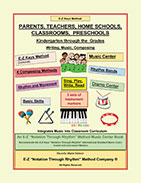
 |
Parents, Teachers, Home Schools, Classrooms, Preschools: Kindergarten Through the Grades Writing, Music, Composing
by Beverly Marie Nelson
Xlibris
The face of music education in this country has changed many times over the years, whether due to budget constraints or standardization of curriculums. The changes are perhaps the most pronounced in the modern era, with more children being homeschooled or engaged in distance learning through computers and broadband internet. The E-Z Notation Through Rhythm Method introduces basic musical concepts like the notes on a scale, basic sheet music, and time signatures using several simple exercises, do-it-yourself instrument creation, and even colorful puppet characters. Children can quickly pick up the fundamentals of music and even songwriting using this simple color-coded and mnemonic system and open a door to understanding music regardless of budget, classroom size, or school structure. Teachers of children of any age can use these lessons as the groundwork for introducing children to the foundations of all music and composition.
Written for those who educate, this book should be a guiding template to help students pick up music in the classroom environment. Loaded with activities and lesson plans to help even the youngest of school children understand the foundations of music education, the read is full of useful ideas that are then implemented practically as interactive exercises. For example, instead of teaching the musical scale as a fact to be memorized, the author includes multiple methods to help children retain the information, using colors, characters, and alliterative phrasing. The lessons are fun, encouraging students to clap, sing, make and play instruments, and learn music by making music, which will excite and engage most children. As a supplement to any existing music education program or as the foundation for any home-based or school-based curriculum, this method is a strong candidate for an ideal way to draw children in and make them excited about learning.